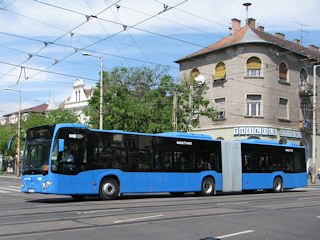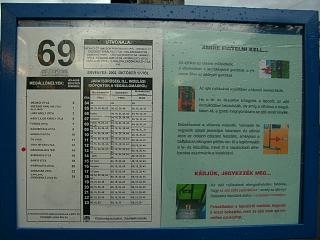Tram-hiker's
guide to Budapest
Latest update: 5. February,
2017
![]()
Closing time, February 2017: Since I don't have the time to work on this website, I won't be updating it anymore.
Tram-hiker's guide to Budapest
Latest update: 5. February, 2017
Closing time, February 2017: Since I don't have the time to work on this website, I won't be updating it anymore.
Organisation of Budapest's public transportation
Rules of thumb - without warranty
Most of the public transportation means in and around Budapest are operated by the municipally owned BKV Zrt. (Budapesti Közlekedési Zártkörű Részvénytársaság), the state-owned Volánbusz company, and private contractors (e.g. VT-Arriva, T&J Kft, etc.). The "big" railway lines are operated by MÁV, the state railway company, but the so-called HÉV lines, a disconnected lot of smaller lines electrified with DC are operated by the BKV. Most of the times when we say "suburban railways" in Budapest, we mean HÉV, although of course there are also suburban services offered on the MÁV lines.
All these different undertakings are coordinated by BKK, the Budapest Transport Center, a relatively new formation taking over many things from the BKV and the municipal authorities. During the last two years some rebranding efforts have been made, so some of the newer vehicles are labelled "BKK" and "Budapest", but older buses and trams are still displaying their actual owners' logos.


To the left: most of BKV's
buses are blue with stripes of other colors. However, a new, brighter blue has been adopted starting in 2012, as seen to the right. The change is not complete, and it is not even meant to be: older vehicles will retain their darker blue.
About zones: there's no real zone fare system in Budapest. Or better: the whole city is one big zone, and what goes out of that zone, is in another zone. If you cross the city limits, you enter the "outer zone". Only bus lines and the Szentendre/Gödöllő/Csömör/Ráckeve HÉV services leave the inner zone, trams don't. Since this page deals mostly with trams, this cames handy: if you have a valid one-day/tourist/seven-day/etc ticket or a monthly pass, you should be okay :-)
About
season/day/week/etc passes on "special" services: these are not valid on
the chair lift and the funicular. Please take a look
at the BKK's website (see link below) and see what kind of tickets/passes
exist, and what is best for you:
[BKK
TICKETS AND PASSES]
Tickets are only valid after you have validated it with the puncher (be it manual or automatic). Controllers (ticket inspectors) can ask for your ticket or pass anywhere and anytime on the vehicle and on BKV property (e.g. on a subway station). They can be recognised from a badge and an armband. If you have a valid pass or ticket, you should be fine, otherwise you might get into a bit of trouble, because most of the ticket inspectors don't speak foreign languages.
![]()
Now the important links - please only believe these, and not what you find on this page - I don't have the time to do regular updates, so I might be outdated, while the BKV/BKK/MÁV website should be not.
[BKK
Ticket Offices]
[BKK
Schedules with Planner]
MÁV (Hungarian State Railways):
[Elvira
- MÁV online schedules]
![]()
The numbering scheme of Budapest public transportation underwent big changes recently: until autumn 2008 trams were numbered between 1 and 69, trolley buses between 70 and 89, while buses could bear any number between 1 and 297, even those used by tram or trolley bus routes. Now one number identificates only one service, for example there's the tram line 6, while the former bus service 6 was renumbered to 206.
Express services are marked by an added "E" after the basic route number, for example the bus line 240E is an express working of bus line 240, having fewer stops then the basic service.
Tram supplementation services are marked with an added "V" behind the number (i.e. 19" or 101V, 201V when there are more such services on different parts of a route). Their destination signs should also be yellow instead of white, but on one hand they often forget about this tradition, on the other hand dot-matrix displays cannot render yellow backgrounds, so mainly you should be looking out for that letter "V"!
Route designations with a number and a letter, e.g. 37A, 8A are insection/off-peak services: mainly short and/or slightly altered and/or limited workings of the original route.
VOLÁNBUSZ bus services have numbers in the regime between 300 and 899.
Nightly bus services are numbered in the 900er regime, i.e. 973.
Destinations ending with a capital M (e.g. Határ út M) mark a terminus with connection to a metro line, while H means the same with a HÉV line.
![]()
There are four
metro (subway, underground, U-Bahn) lines.
M1 or Yellow
Line is the Milleneum Subway or "Shallow Subway Line", mostly referred
to as "kisföldalatti" ("small subway"). This is the classic underground
tramway line built in 1896 and extended in 1973.
M2 or Red
Line, also referred to as "keleti-nyugati vonal" ("east-west line"): opened
in two steps in 1970 and 1972.
M3 or Blue
Line, also referred to as "észak-déli vonal" ("north-south line"): opened
in many steps between 1972 and 1989.
M4
opened in Spring 2014.
![]()


To the left: a "normal"
tram stop notice-board. To the right: an orange notice-board with warnings
for changes in the traffic.
A remark about detours, changes in the schedule or route: if you see orange/yellow signs or notice-boards in the stops, they usually draw attention to some kind of alteration in the traffic. Or they might be just a forecast for changes, you must find out by looking for dates on the notice-board. During big detours however, you can see warning signs in english, too.
A digital information system (displays at stops) is in use at more frequented stops since 2014, and it's also available as an app for smartphones!
![]()
A few important words in hungarian
The hungarian language is hard to learn, because it's different to most other european languages - so I won't try to teach you how to conversate. At the end of this paragraph you can find a couple of links, if you want to try that - meanwhile I'd go for a few public transportation oriented and everyday terms. (Thanks to "vrobee" for his help in this!)
Let's start with names
of places:
"út" (oot) = road, street
"utca" (oot-tza) = street (usually a smaller one than an "út")
"tér" (tehr) = square, sometimes used as "tere" as in "Örs vezér tere", which is in posessive case, meaning "Square of Örs vezér"
"körút" (cur-oot) = boulevard, circuit
"köz" (cuz) = alley
"város" (vah-rosh) = city, town
"városi" (vah-ro-she) = municipal, urban
"híd" (heed) = bridge
"sziget" (sig-at) = island
"hegy" (headj) = hill, mountain
"szálloda" (sahl-low-da) or "szálló" (sahl-low) = hotel
![]()
Now, the names of the transportation means and related things:
"kocsi" (ko-chy) = car, coach, waggon; in fact "coach" is one of the very few words coming to english from hungarian:
Kocs ("coch") was a village where a new, faster and lighter type of cart was first built
"pótkocsi" (pawt-ko-chy) = trailer, trailing car (even if it's in the middle of a train:)
"motorkocsi" (mo-tor-ko-chy) = railcar, motorcar
"metró" (met-roh) = subway, underground railway, metro
"villamos" (vill-ah-mosh) = tram
"trolibusz" (trol-lee-boos) = trolley bus
"busz" (boos) = bus
"HÉV" (heyv) = abr. for "helyiérdekű vasút" = vicinal railway
"vonat" (vo-not) = train
"vasút" (vash-oot) = railway, railroad
"vonal" (vo-nahl) = line, route
"járat" (yah-rot) = route, service
"szerelvény" (ser-al-vehn) = set (as in coupled, double-set, multiple unit), train
"megálló" (meg-ahl-low) = stop as in "tram stop", originally a shorter form of "megállóhely"
(meg-ah-low-h-ey) = stop
"hely" (hey) = place, location. locality, site
"állomás" (awl-lo-mush) = station
"végállomás" (wehg-awl-lo-mush) = terminus, abreviated on route designations, etc as "vá."
"pályaudvar" (pah-yah-ood-vahr) = a bigger railway station
"dél" (dehl) = south -> "déli" = southern, as in "Déli Pályaudvar" = "Southern Station" or "Budapest South"
"kelet" (ke-leth) = east -> "keleti" = eastern
"észak" (ey-sock) = north -> "északi" = northern
"nyugat" (new-gath) = west -> "nyugati" = western
"jegy" (yedj) = ticket
"bérlet" (behr-let) = seasonal pass
"útlevél" (oot-leh-vehl) = passport
Remark: Proper names like of a certain bridge, mountain, street, hospital, hotel, etc begin with a capital letter, e.g. "Gellért-hegy" (Gellert Hill).
Common nouns (common words like "street", "square", etc) however begin with a small letter as in "pályaudvar" (station).
I think this is enough to understand a map on your own, or understand what you should search for when hearing the name of a place.
![]()
A few polite words:
"Jó reggelt!" (yow rag-galt) = Good morning!
"Jó napot!" (yow nah-pot) = Good day!
"Jó estét!" (yow ash-tate) = Good evening!
"Elnézést!" (al-naze-eysht) = Excuse me!
"Kérem!" (kaye-ram) = Please!
"Köszönöm!" (cu-su-num) = Thank you!
"Viszontlátásra!" (vee-sont-lah-tah-shra) = Good-bye!
"Szabad ez a hely?" (sobod ez ah hey) = Is this seat free?
Oh yes, and two of the probably most important words (thank you, Malcolm Blunden, for pointing out these missing):
"igen" (ee-gan) = yes
"nem" (nehm) = no
[Information
about the hungarian language]
[Online
hungarian-english dictionary]
![]()
Budapest is in the same time zone as most Central European countries - like Germany or Austria - but since it's quite on the eastern verge of that zone, daylight conditions are a bit different. It gets bright earlier, but it also gets dark earlier! While you can still take nice photos in Germany around 9:00PM in the summertime, there's already dusk over here. Therefore it's wise to wake up early in the morning and leave late evening for non-photographing activities :-)
To be granted an entry into a depot, you must ask BKV for a written permission. Regulations are quite strict, so the personnel is not allowed to let you in without a written permit even if you ask nicely, and even if you only want to take a few photos. They also don't like photographers in metro stations. Also, make sure not to impede traffic, not to cause inconvienence to passengers and personnel, not to use flash light, and keep out of spaces, where trespass is prohibited. I know this may seem very strict, so I feel I must mention the other extremities, too: there are many drivers who are transportation enthusiasts and photographers themselves, too :-)
![]()
Next page: Introduction to the rolling stock
Back
to the index
Disclaimer: The author cannot
be held responsible for mistakes, misinterpretations, inaccuracies, inactualities,
etc. on/of these pages, nor for the content of other pages linked in.
![]()
Send
a mail to the author
The
author's homepage